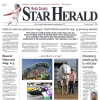By Sara Strong
The Luverne Planning Commission jump-started this year by drafting a few changes for the code books.
Commission members had a final reading of their drafts Tuesday and will host a meeting April 1 to give residents the opportunity to discuss some of the proposed changes.
Junk vehicles and parking have been specific hassles for the city in the past. In its past few meetings, the Commission has tried to tailor parts of the code to keep the city attractive and safe while protecting property owners’ rights.
One proposed change bans all parking on front lawns, during all seasons. For parking in the back yard, the Commission said that three vehicles (which also includes trailers, snowmobiles, boats, campers and others) is the maximum allowed.
Junk vehicles
The Commission is using definitions outlined in state statutes.
An "abandoned vehicle" is one that has been parked: for more than 48 hours on any property owned or controlled by a unit of government, or for more than four hours where it is properly posted; or on private property without the consent of the person in control of the property.
Abandoned vehicles are also those that lack vital component parts and are inoperable such that it has no potential for further use. If that is the case, it must be kept in an enclosed garage or storage building.
Classics or pioneer cars will not be considered junk.
A "junk vehicle" is one that is extensively damaged; is apparently inoperable; does not have a valid, current registration plate and has an approximate fair market value equal only to the approximate value of the scrap in it.
Simply keeping current registration tabs on a junk vehicle’s license plate won’t prevent citations.
The Commission concluded Tuesday that vehicle repairs may be done in the open, but for no longer than 30 days. No tools or parts can be left outside, by the car, and must be stored in a structure when someone isn’t actively working on a vehicle.
Within those 30 days of allowable repair time, a cover specifically designed for cars can be used, but blue plastic tarps tied down with bricks, for example, are not allowed.
Covering the vehicles with a tarp, as had been done in the past to avoid zoning officials, will no longer be considered an effective means of containing junk vehicles or ones being repaired.
The 30-day repair clause doesn’t apply to people who are storing junk vehicles, claiming to be restoring them. Repairs can be done in the open only on licensed and operable vehicles.
Parking
The Planning Commission said in a draft that "parking … on unpaved areas destroys landscaping and the general aesthetics of a neighborhood. Toxic wastes can enter the water table if vehicles leak oil or other fluids. Far from being merely an annoyance, lawn parking affects neighborhood pride and signals the beginning of economic decline."
If the proposed changes go through, there will be no parking in front lawns, and there can be only three vehicles in the back yard.
The Commission doesn’t have specifics outlined yet, but in the future, it plans to include a requirement that back yard parking be on a paved or graveled surface. That means simply driving onto grass will not be acceptable.
The Commission said that junk vehicles and the damage they cause to property values, city pride and the environment are its main concern now.
Selling vehicles
Residents are also prohibited from displaying a vehicle for sale without a license from the state to operate as a car dealer. That really means that vacant lots can’t be used to display "For Sale By Owner" vehicles.
People can still sell their own cars, but the Planning Commission doesn’t want stray vehicles in random locations around town. People selling their own vehicles have commonly parked them in high visibility areas.
If the proposed changes go through, vehicles for sale by owner can be labeled as such and parked in driveways or on public streets. Car dealerships will typically sell vehicles for people on consignment as well.
All vehicles in dealership lots must be parked on paved areas.
Fences
The city doesn’t want to involve itself in disputes regarding fences at property lines. The Planning Commission proposes that the code make clear that property owners are responsible for getting their own property lines drawn by a surveyor.
The city asks that residents work with neighbors on fencing issues. Maintenance of both sides of the fence is the responsibility of the fence owner, including mowing and painting.
The city of Luverne won’t determine which side of the fence or in what manner the fence should be "finished" either. It only requires that the fence be of solid material and in compliance with height restrictions.
Room to breathe
The city passes a couple hundred variance requests a year for side setback requirements.
The Board of Appeals and Adjustments has yet to turn down a request to allow a 5-foot setback, so the Planning Commission wants to set the standard to 5 feet.
Now, it is supposed to be 10 percent of the lot frontage, but when the city was planned, people didn’t have double-car garages and it’s been a problem for home owners making additions.
Subdivisions of town, Evergreen for example, can create their own covenants and specify setbacks.



